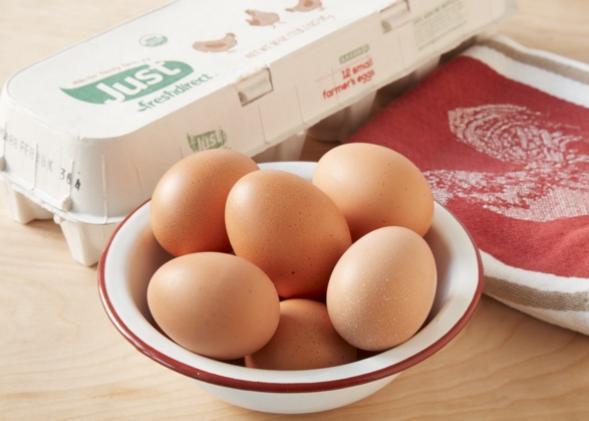When I heard that FreshDirect, a New York-based grocery delivery service, had begun selling “small farmer’s eggs,” I was skeptical. “They are eggs laid by young chickens that are smaller than typical eggs sold in grocery stores, and many farmers say they taste best,” read the invitation to a press event at which the eggs would be served. The email went on to explain that these miniature eggs are usually sold to food processors or thrown away, and that buying them from FreshDirect would “create more profit for the farmers, helping to make organic farming more sustainable.” It sounded bogus: FreshDirect wanted me to buy something that farmers usually throw away and was claiming this would help support sustainable agriculture?
But when I tasted my first “farmer’s egg”—or pullet egg, as they’re more traditionally and less poetically known—I found myself also eating crow: It really did taste better than the large eggs I usually buy at the grocery store. The white was less rubbery, and the yolk was far creamier. And it just tasted, well, eggier than most eggs—it was assertively savory on its own, whereas most eggs I’ve eaten require ample cheese and salt to mask their blandness. Mike Alderfer, the co-owner of the farm that supplies FreshDirect with pullet eggs, told me that young chickens are pickier eaters than older chickens, and their preference for corn results in richer-tasting eggs.
The experience made me wonder. Why, if pullet eggs taste better than bigger eggs, is it impossible to find small eggs at most grocery stores?
Part of the answer has to do with biology. Hens lay eggs for an average of 13 months total, beginning when they’re about 18 weeks old. The older they get, the larger their eggs. (Farmers can manipulate egg size by tweaking the hens’ feed or environment, but as a rule, egg size correlates with hens’ age.) Hens produce small eggs—defined by the USDA as weighing between 18 and 21 ounces per dozen—only during the first month or so of their egg-laying careers. (Very young chickens occasionally lay “peewee eggs,” weighing less than 18 ounces per dozen—and yes, “peewee” is the term the USDA uses.) Young chickens lay eggs fairly infrequently, just one every few days or so.
When hens get older, not only do their eggs get bigger, but they lay more frequently—up to an egg a day. “During a hen’s most productive egg laying period is when the hen lays large size eggs,” Elisa Maloberti, the director of egg product marketing for the American Egg Board, told me in an email. So most eggs laid by commercial hens are large eggs (defined by the USDA as weighing between 24 and 27 ounces per dozen).
This doesn’t explain why it’s virtually impossible to find small eggs at any retailer other than FreshDirect (and the occasional farmer’s market) these days. But it does hint at a few possibilities. Not all of the eggs produced in this country are sold in grocery stores—many of them are sold to “breaking plants” that liquefy, freeze, or dry them for use in processed food products. The proportion of eggs processed in this way has increased over the past 30 years. Maloberti suspects that as the industry’s demand for liquid, frozen, and dried eggs has increased, the more small eggs have been diverted from grocery stores to breaking plants.
But why isn’t there consumer demand for small eggs? I suspect there’s a feedback loop in play. Large eggs are the most commonly available egg size. Subsequently, recipe writers (including, I’m sorry to say, yours truly), develop recipes using large eggs. The ubiquity of recipes calling for large eggs increases consumer demand for large eggs. Repeat.
There may also be good, old-fashioned ignorance and size-chauvinism involved. Most people—including me, earlier this week—don’t know that small eggs taste better. And if you’re working from the assumption that all eggs taste the same, bigger eggs probably seem like a better deal.
But taste isn’t the only reason to favor small eggs over large: Poultry experts say that laying large eggs is painful for hens, which, you know, makes sense. It’s conceivable that lower demand for large eggs would lead to less chicken suffering. Industrial farmers often induce molting in egg-laying hens to extend the period of time during which they lay large eggs. If consumers prized pullet eggs, farmers might let hens follow a more natural production cycle instead of trying to maximize their output of large eggs.
Of course, most consumers don’t have the privilege of buying pullet eggs, unless they live near an independent egg producer or in FreshDirect’s delivery zone. But there are good reasons for people who do have access to pullet eggs to seek them out. If enough people ask for them, who knows? Producers might start selling them to grocery stores, instead of letting their flavor go to waste in processed foods.
